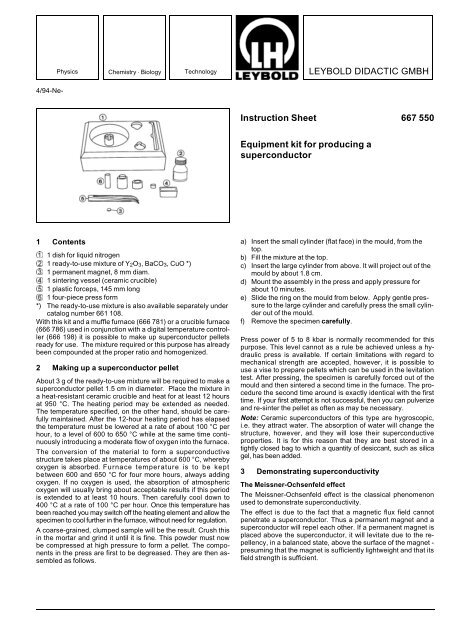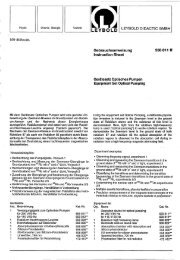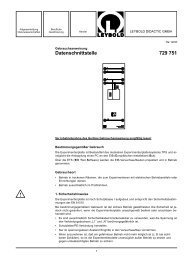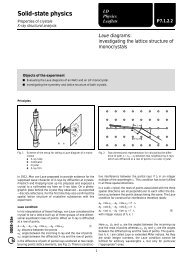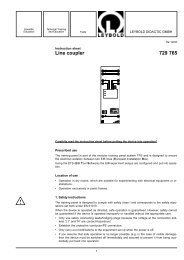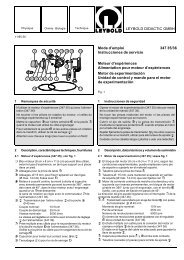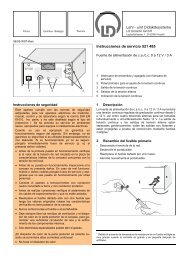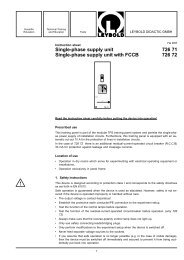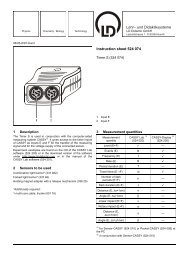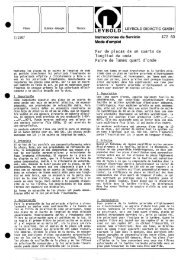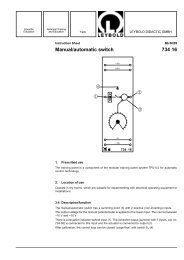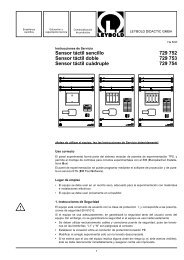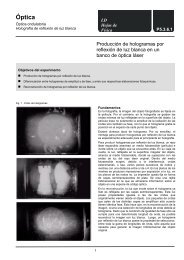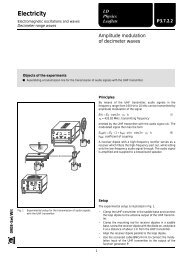LEYBOLD DIDACTIC GMBH Instruction Sheet 667 550 Equipment ...
LEYBOLD DIDACTIC GMBH Instruction Sheet 667 550 Equipment ...
LEYBOLD DIDACTIC GMBH Instruction Sheet 667 550 Equipment ...
You also want an ePaper? Increase the reach of your titles
YUMPU automatically turns print PDFs into web optimized ePapers that Google loves.
4/94-Ne-<br />
Physics Chemistry ⋅ Biology Technology <strong>LEYBOLD</strong> <strong>DIDACTIC</strong> <strong>GMBH</strong><br />
1 Contents<br />
� 1 dish for liquid nitrogen<br />
� 1 ready-to-use mixture of Y2O3, BaCO3, CuO *)<br />
� 1 permanent magnet, 8 mm diam.<br />
� 1 sintering vessel (ceramic crucible)<br />
� 1 plastic forceps, 145 mm long<br />
� 1 four-piece press form<br />
*) The ready-to-use mixture is also available separately under<br />
catalog number 661 108.<br />
With this kit and a muffle furnace (666 781) or a crucible furnace<br />
(666 786) used in conjunction with a digital temperature controller<br />
(666 198) it is possible to make up superconductor pellets<br />
ready for use. The mixture required or this purpose has already<br />
been compounded at the proper ratio and homogenized.<br />
2 Making up a superconductor pellet<br />
About 3 g of the ready-to-use mixture will be required to make a<br />
superconductor pellet 1.5 cm in diameter. Place the mixture in<br />
a heat-resistant ceramic crucible and heat for at least 12 hours<br />
at 950 °C. The heating period may be extended as needed.<br />
The temperature specified, on the other hand, should be carefully<br />
maintained. After the 12-hour heating period has elapsed<br />
the temperature must be lowered at a rate of about 100 °C per<br />
hour, to a level of 600 to 650 °C while at the same time continuously<br />
introducing a moderate flow of oxygen into the furnace.<br />
The conversion of the material to form a superconductive<br />
structure takes place at temperatures of about 600 °C, whereby<br />
oxygen is absorbed. Furnace temperature is to be kept<br />
between 600 and 650 °C for four more hours, always adding<br />
oxygen. If no oxygen is used, the absorption of atmospheric<br />
oxygen will usually bring about acceptable results if this period<br />
is extended to at least 10 hours. Then carefully cool down to<br />
400 °C at a rate of 100 °C per hour. Once this temperature has<br />
been reached you may switch off the heating element and allow the<br />
specimen to cool further in the furnace, without need for regulation.<br />
A coarse-grained, clumped sample will be the result. Crush this<br />
in the mortar and grind it until it is fine. This powder must now<br />
be compressed at high pressure to form a pellet. The components<br />
in the press are first to be degreased. They are then assembled<br />
as follows.<br />
<strong>Instruction</strong> <strong>Sheet</strong> <strong>667</strong> <strong>550</strong><br />
<strong>Equipment</strong> kit for producing a<br />
superconductor<br />
a) Insert the small cylinder (flat face) in the mould, from the<br />
top.<br />
b) Fill the mixture at the top.<br />
c) Insert the large cylinder from above. It will project out of the<br />
mould by about 1.8 cm.<br />
d) Mount the assembly in the press and apply pressure for<br />
about 10 minutes.<br />
e) Slide the ring on the mould from below. Apply gentle pressure<br />
to the large cylinder and carefully press the small cylinder<br />
out of the mould.<br />
f) Remove the specimen carefully.<br />
Press power of 5 to 8 kbar is normally recommended for this<br />
purpose. This level cannot as a rule be achieved unless a hydraulic<br />
press is available. If certain limitations with regard to<br />
mechanical strength are accepted, however, it is possible to<br />
use a vise to prepare pellets which can be used in the levitation<br />
test. After pressing, the specimen is carefully forced out of the<br />
mould and then sintered a second time in the furnace. The procedure<br />
the second time around is exactly identical with the first<br />
time. If your first attempt is not successful, then you can pulverize<br />
and re-sinter the pellet as often as may be necessary.<br />
Note: Ceramic superconductors of this type are hygroscopic,<br />
i.e. they attract water. The absorption of water will change the<br />
structure, however, and they will lose their superconductive<br />
properties. It is for this reason that they are best stored in a<br />
tightly closed bag to which a quantity of desiccant, such as silica<br />
gel, has been added.<br />
3 Demonstrating superconductivity<br />
The Meissner-Ochsenfeld effect<br />
The Meissner-Ochsenfeld effect is the classical phenomenon<br />
used to demonstrate superconductivity.<br />
The effect is due to the fact that a magnetic flux field cannot<br />
penetrate a superconductor. Thus a permanent magnet and a<br />
superconductor will repel each other. If a permanent magnet is<br />
placed above the superconductor, it will levitate due to the repellency,<br />
in a balanced state, above the surface of the magnet -<br />
presuming that the magnet is sufficiently lightweight and that its<br />
field strength is sufficient.
4 Conducting the demonstration<br />
The superconductor pellet is placed in the center of the dish.<br />
The dish is then filled with liquid nitrogen so that the pellet is just<br />
barely covered.<br />
Note:<br />
Protective goggles and gloves must be worn when working with<br />
liquid nitrogen. The requirements of all safety codes and regulations<br />
governing the handling of hazardous materials shall be<br />
observed.<br />
The nitrogen will initially boil violently. Once boiling has subsided,<br />
use the plastic forceps to position the permanent magnet<br />
above the superconductor pellet. It will float about 7 mm above<br />
the superconductor.<br />
5 Liquid nitrogen - a problem?<br />
Liquid nitrogen has today become a commonly used cooling<br />
medium in many technical and industrial applications. This is<br />
particularly because it is economical and easy to handle.<br />
You will require 1 to 2 litres of nitrogen for a series of experiments<br />
in a classroom hour. Large-volume users are often willing<br />
to make these quantities available for school use at no cost.<br />
Liquid nitrogen is used in many and varied fields so that it can<br />
almost always be obtained from a nearby source at minimal<br />
effort. The following list of users, which is by no way complete,<br />
will illustrate this fact: university and hospital laboratories;<br />
agricultural cold-storage plants and insemination stations;<br />
manufacturers and processors of plastics; rubber processing<br />
operations; plastic film manufacturers and surface coatings<br />
companies; the tire industry; blood banks; manufacturers of<br />
serums, plasma or pharmaceutical products; deep-frozen<br />
foods manufacturers; shipping companies which transport<br />
perishable products; manufacturers of powders - regardless of<br />
whether powder-coat paints or instant soups.<br />
<strong>LEYBOLD</strong> <strong>DIDACTIC</strong> <strong>GMBH</strong> ⋅ Leyboldstrasse 1 ⋅ D-50354 Hürth ⋅ Phone (02233) 604-0 ⋅ Telefax (02233) 604-222 ⋅ Telex 17 223 332 LHPCGN<br />
© by Leybold Didactic GmbH, Printed in the Federal Republic of Germany<br />
Technical alterations reserved


